Bioplastic Packaging Market Size
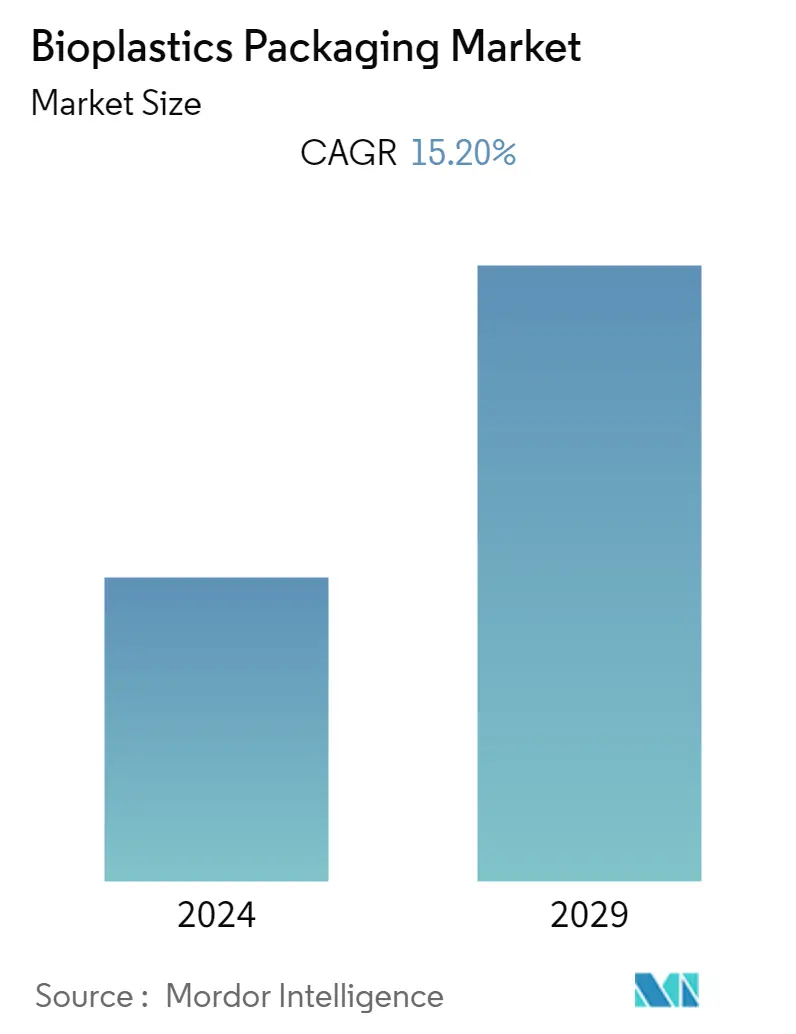
| Study Period | 2019 - 2029 |
| Base Year For Estimation | 2023 |
| CAGR | 15.20 % |
| Fastest Growing Market | Asia Pacific |
| Largest Market | Europe |
| Market Concentration | Low |
Major Players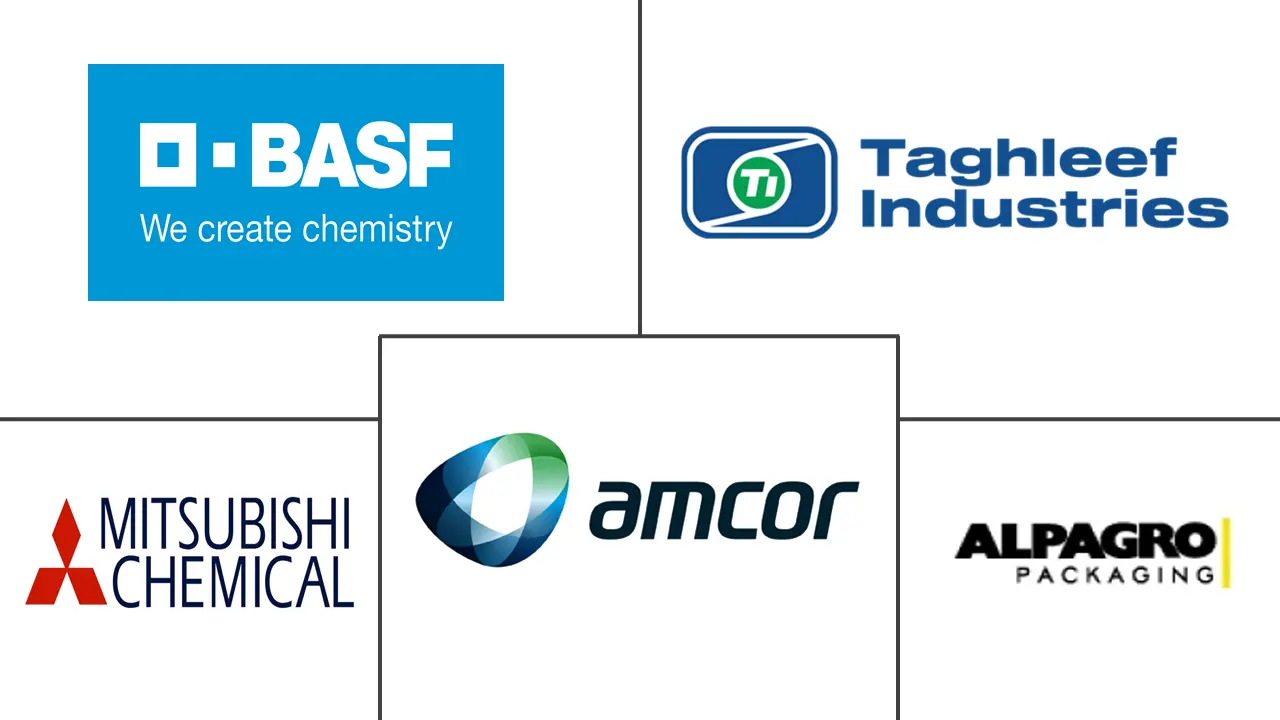
*Disclaimer: Major Players sorted in no particular order |
Bioplastic Packaging Market Analysis
Bioplastics Packaging Market is expected to register a CAGR of 15.2% over the forecast period. Bioplastics packaging solutions are finding increasing applications in packaging owing to their low environmental impact, growing focus on recyclability and sustainability, government emphasis on efficient packaging management, and rising consumer awareness, coupled with increasing bans on single-use plastic.
- The overarching issue of climate change and the future scarcity of fossil resources accelerated the search for better plastic packaging concepts. Stringent government regulations against the use of conventional plastics have propelled the demand for bioplastics. Bioplastics have the potential to bypass the environmental impacts of petroleum-based plastic packaging.
- Bioplastics are plastic materials created by combining various biodegradable materials, such as biomass (plants, trees, and waste).Such materials can be utilized to reduce the dependence on fossil fuel-based plastic packaging, eventually increasing the use of green products and boosting sustainability and an inclination toward environmental protection.
- Also, governments worldwide are responding to concerns regarding packaging waste, especially plastic packaging waste, and are implementing regulations to minimize environmental waste and improve waste management processes. In all parts of the world, governments are putting more pressure on people to use traditional plastics, which is helping bioplastic grow as a stable alternative in the packaging industry.
- Emerging economies, like India, which are heavily dependent on single-use plastics, are witnessing the rigorous roll-out of legislation that bans the use of single-use plastics. For example, the environment ministry announced in August 2021 that single-use plastic items would be banned beginning July 1, 2022.The country is anticipated to witness heavy developments in the market studied to align the country's goals laid out in the Plastic Waste Management Amendment Rules, 2021.
- According to European Bioplastics (Association of Bioplastics), global bioplastics production capacity is set to increase from 2.11 million metric tons in 2020 to approximately 2.7 million metric tons in 2025. In 2020, the organization said, 1,227 metric tons of biodegradable bioplastics and 884 metric tons of bio-based non-biodegradable bioplastics were made.
- Furthermore, rising government and regulatory initiatives to promote bioplastics usage are expected to drive market growth over the forecast period.For instance, Japan unveiled a new policy to increase plant-based bioplastics to tackle marine plastic waste. in a move that would see the country recycle 100% of newly produced plastics by 2035 and promote bioplastics from plant-based sources.
- Amid the COVID-19 pandemic, the growth of the bioplastics packaging market has been severely stunted. The supply chain disruption, price hike of the raw material, and lockdowns had heavily impacted the growing market before the pandemic hit.
Moreover, changes in consumer behavior during the COVID-19 pandemic required actions concerning the adoption of bioplastics for single-use food packaging. Polylactide (PLA) was anticipated to witness significant growth due to its high production viability, performance comparable to petroleum-based thermoplastics, and carbon-neutral life cycle in the market studied over the forecast period. Further, the Russia-Ukraine war had an impact on the overall packaging ecosystem.
Bioplastic Packaging Market Trends
This section covers the major market trends shaping the Bioplastics Packaging Market according to our research experts:
Rigid Packaging to Hold Dominant Position in the Market
- Rigid bioplastics are used for the packaging of cosmetics such as compact powders, lipsticks, creams, and beverage bottles. A broad application base increases the scope for demand. Materials such as bio-based PE, PLA, or bio-based PET are used in the section.
- According to statistics from the FEA, Germany produces almost 6.28 million tons of plastic waste each year, and globally, the figure is about 400 million tons. In general, a plastic bottle takes approximately 500 to 1,000 years to decompose. Such stats showcase the need for bioplastics in rigid packaging products, such as bottles, tubes, cups, cutlery, blister packaging, etc., which could significantly reduce the decomposition time.
- In the context of rising environmental awareness, several well-known brands, such as Vittel, Coca-Cola, Heinz, and Volvic, have started using bio-based PET for making bottles of all sizes that contain sparkling drinks and other non-gaseous fluids and solutions. A significant number of companies like Johnson & Johnson and Procter & Gamble rely on bio-based PE to package several cosmetic products.
- Because these products contain a large amount of bio-based materials and can be mixed with suitable recyclates from traditional PE and PET, resource efficiency has increased and carbon dioxide emissions have gone down.
Given the growing popularity of bio-plastics, numerous bioplastics application technologies are being discovered in developed countries with significant research and development funding. For instance, in July 2021, Brown University students developed a bioplastic "Fette" cup to replace solo cups. The solo cups are made from number six plastic, which is chemically identical to Styrofoam and toxic for the environment.
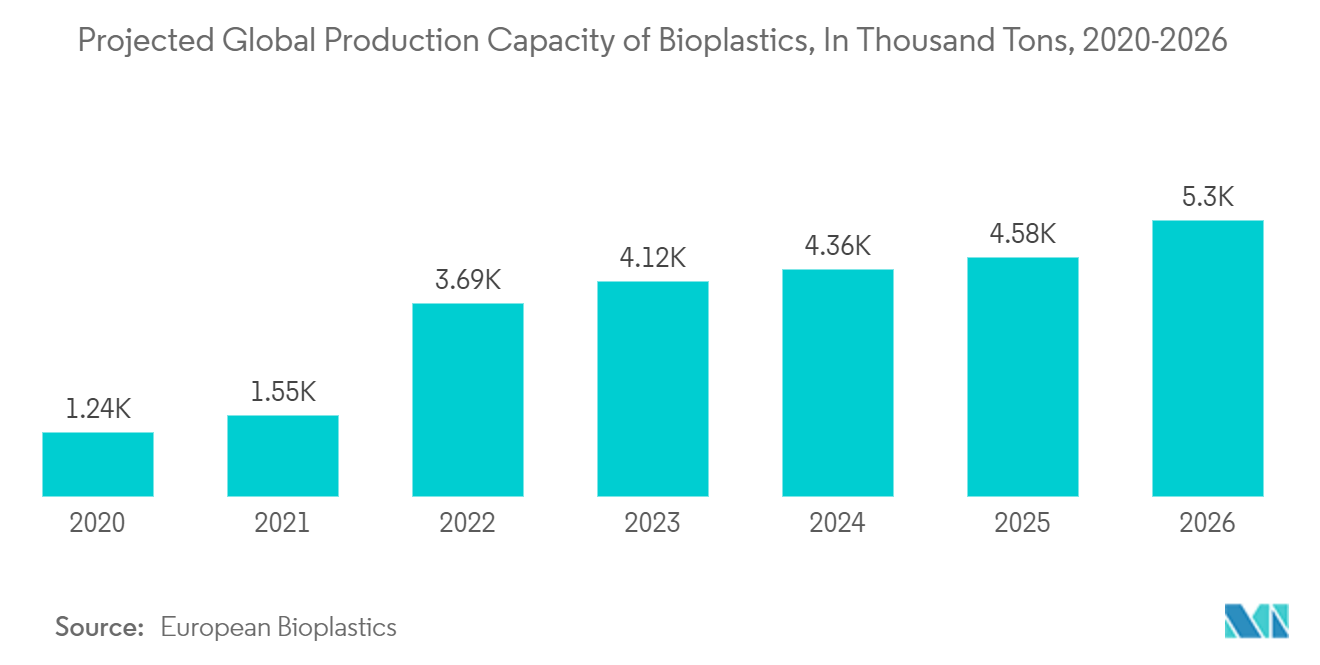
Europe Holds a Significant Market Share
- The European Union (EU) is working towards the 2050 net-zero emissions goal and tackling the increasing environmental and sustainability crises by implementing the European Green Deal. The inclination towards a more sustainable society is intertwined with the European economy's production, use, and disposal of plastic.
- Europe strengthened its position as a central hub for the entire bioplastics industry and ranked foremost in the field of research and development, having this industry's largest market worldwide. By now, nearly one-fourth of the overall bioplastics production capacity is located in Europe.
- Furthermore, consumers in the region are increasingly becoming aware of the effects of plastic and non-biodegradable packaging on the environment. The demand for green packaging, including bioplastic packaging, is on the rise in the region.
- Governments and other regulatory bodies in the region are coming up with more and more ways to promote and incentivize the use of bioplastics for packaging.
Aside from its contributions to a more sustainable future, the emerging bioplastics industry has the potential to have a massive economic impact in Europe over the next few decades. According to a market analysis conducted by EuropaBio, the European bioplastics industry could realize steep employment growth, most of which will positively affect the development of rural areas.
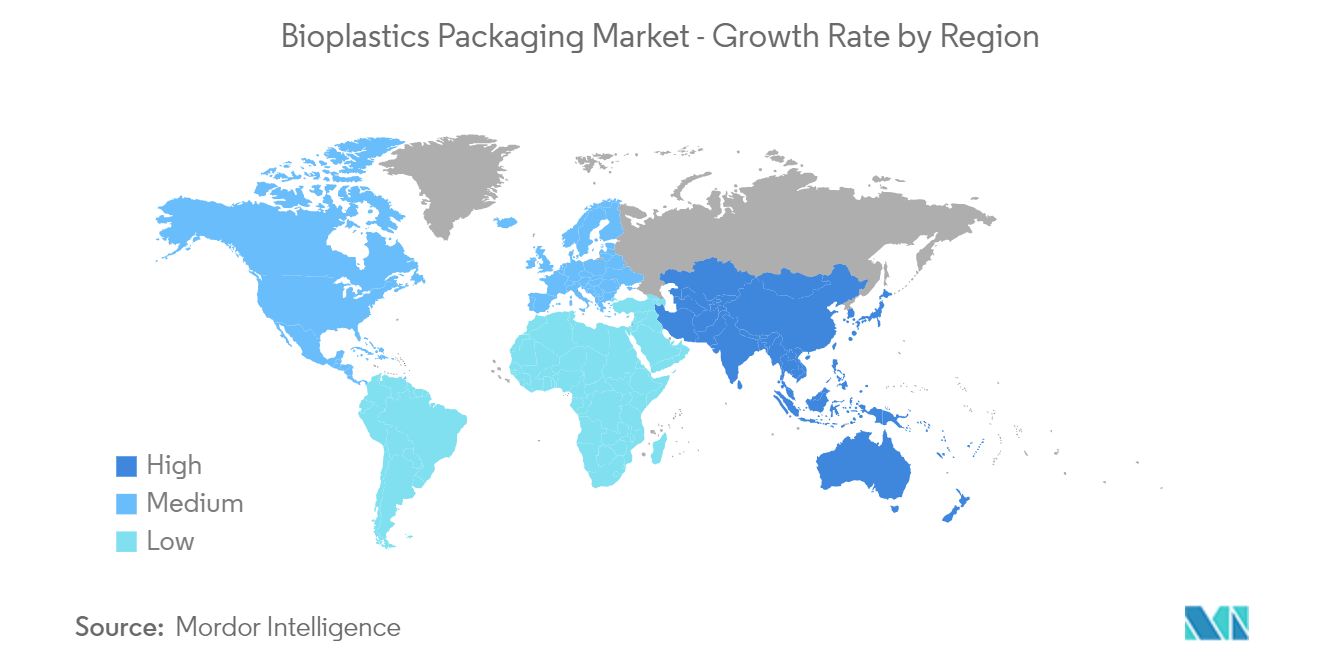
Bioplastic Packaging Industry Overview
The Global Bioplastics Packaging market consists of several major players. The major players with a prominent share in the market are focusing on expanding their customer base across the regions and their end-user industry base. These companies are leveraging strategic collaborative initiatives to increase their market share and profitability. Some of the major players operating in the market include BASF SE, Taghleef Industries Group, Alpagro Packaging, and Amcor Ltd. Some of the recent developments in the market are:
In July 2022, Taghleef Industries collaborated with the Emirates Environmental Group to protect the environment and develop a sustainable community within the Middle East. EEG is a group of professionals who work together to protect the environment through education, action programs, and involvement in the community.
In July 2022, applications were added to the Terratek BD portfolio by Green Dot Bioplastics, a developer and producer of bioplastic materials for creative, sustainable end uses. The increased selection for film extrusion, thermoforming, and injection molding is consistent with Green Dot Bioplastics' objective to address rising sustainability demands from brand owners and customers while achieving faster rates of biodegradability.
Bioplastic Packaging Market Leaders
-
BASF SE (Badische Anilin- und Soda-Fabrik)
-
TAGHLEEF INDUSTRIES GROUP
-
Mitsubishi Chemical Corporation
-
Alpagro Packaging
-
Amcor Limited
*Disclaimer: Major Players sorted in no particular order
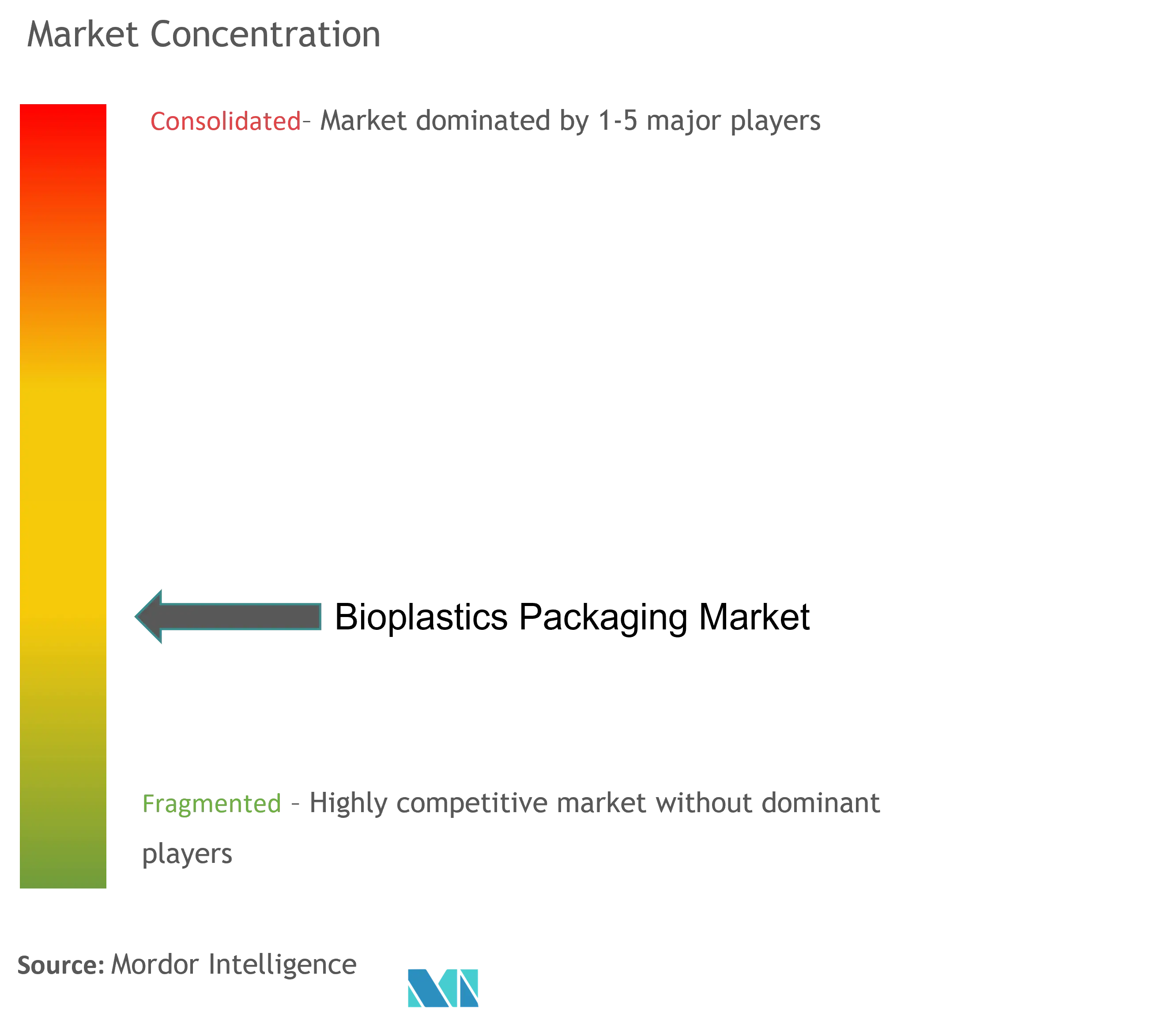
Bioplastic Packaging Market News
- August 2022: LG Chem Ltd., the largest Korean chemical firm, announced a partnership with the US-based food processing organization Archer Daniels Midland Co. (ADM) to build two manufacturing plants in Illinois, US. The production facilities will be manufacturing biodegradable plastics that are extensively used in food packaging applications.
- January 2022: Vikas Ecotech Limited announced its plans to invest in the environment-friendly BioPlastics (PHA) technology and is in the advanced stage of finalizing a technology tie-up or joint venture with Aurapha Private Ltd. (the "AuraPHA") to produce biodegradable plastics. The solution is to adopt biodegradable plastics such as polyhydroxyalkanoates (PHA).
Bioplastic Packaging Market Report - Table of Contents
1. INTRODUCTION
- 1.1 Study Assumptions and Market Definition
- 1.2 Scope of the Study
2. RESEARCH METHODOLOGY
3. EXECUTIVE SUMMARY
4. MARKET INSIGHTS
- 4.1 Market Overview
- 4.2 Industry Value Chain Analysis
-
4.3 Industry Attractiveness - Porter's Five Forces Analysis
- 4.3.1 Bargaining Power of Suppliers
- 4.3.2 Bargaining Power of Buyers
- 4.3.3 Threat of New Entrants
- 4.3.4 Threat of Substitute Products
- 4.3.5 Intensity of Competitive Rivalry
- 4.4 Assessment of COVID-19 Impact on the Market
5. MARKET DYNAMICS
-
5.1 Market Drivers
- 5.1.1 Stringent Government Regulations against the Use of Conventional Plastics
- 5.1.2 Increased Usage of Green Products, Sustainability, and Inclination toward Environment Protection
-
5.2 Market Challenges
- 5.2.1 High Production Cost and Lack of Supply of Bio-plastics
6. MARKET SEGMENTATION
-
6.1 By Material Type
- 6.1.1 BIO - PET
- 6.1.2 BIO - PE
- 6.1.3 BIO - PA
- 6.1.4 Other Bio-Based/Non-Biodegradable Materials
- 6.1.5 Starch Blends
- 6.1.6 PLA
- 6.1.7 PBAT
- 6.1.8 PHA
- 6.1.9 Other Biodegradable Materials
-
6.2 By Product Type
- 6.2.1 Rigid Plastic Packaging (Bottle, Tray, Tubes, Caps, Cups, Cutlery, Blister Packaging) Non-biodegradable Biopolymers
- 6.2.2 Flexible Packaging (Pouch, Film, Labels, and Others)
-
6.3 By End-user Industries
- 6.3.1 Food
- 6.3.2 Beverage
- 6.3.3 Pharmaceuticals
- 6.3.4 Personal Care & Household Care
- 6.3.5 Other End-user Applications
-
6.4 By Geography
- 6.4.1 North America
- 6.4.2 Europe
- 6.4.3 Asia Pacific
- 6.4.4 Latin America
- 6.4.5 Middle East and Africa
7. COMPETITIVE LANDSCAPE
-
7.1 Company Profiles
- 7.1.1 Taghleef Industries Group
- 7.1.2 BASF SE
- 7.1.3 Mitsubishi Chemicals Corporation
- 7.1.4 Alpagro Packaging
- 7.1.5 Biome Bioplastics Limited
- 7.1.6 FKuR Ploymers GmbH
- 7.1.7 Raepak Ltd.
- 7.1.8 COMPOSTPACK SAS
- 7.1.9 Eastman Chemical Company
- 7.1.10 Element Packaging Ltd
- 7.1.11 Treemera GmbH
- 7.1.12 Plasto Manufacturing Company
- 7.1.13 Arkema SA
- 7.1.14 Tipa-corp Ltd.
- 7.1.15 Minima Technology
- 7.1.16 Mondi PLC
- 7.1.17 Amcor Limited
- 7.1.18 Plastic Suppliers Inc.
- 7.1.19 Biogreen Packaging Pvt. Ltd.
- 7.1.20 Tetra Pak International SA
- *List Not Exhaustive
8. INVESTMENT ANALYSIS
9. FUTURE OF THE MARKET
** Subject To AvailablityBioplastic Packaging Industry Segmentation
Bioplastics are plastics derived from organic sources such as corn starch and are often polylactic acid (PLA). These plastics are increasingly being adopted in the packaging industry due to their ability to break down easily and quickly compared to standard plastics. Bioplastics Packaging Market is segmented by Material Type (BIO - PET, BIO - PE, BIO - PA, Starch Blends, PLA, PBAT, PHA), Product Type (Rigid Plastic Packaging, Flexible Packaging), End-user Industries (Food, Beverage, Pharmaceuticals, Personal Care & Household Care), and Geography (North America, Europe, Asia Pacific, Latin America, Middle East and Africa).
The market sizes and forecasts are provided in terms of value (USD million) for all the above segments.
| By Material Type | BIO - PET |
| BIO - PE | |
| BIO - PA | |
| Other Bio-Based/Non-Biodegradable Materials | |
| Starch Blends | |
| PLA | |
| PBAT | |
| PHA | |
| Other Biodegradable Materials | |
| By Product Type | Rigid Plastic Packaging (Bottle, Tray, Tubes, Caps, Cups, Cutlery, Blister Packaging) Non-biodegradable Biopolymers |
| Flexible Packaging (Pouch, Film, Labels, and Others) | |
| By End-user Industries | Food |
| Beverage | |
| Pharmaceuticals | |
| Personal Care & Household Care | |
| Other End-user Applications | |
| By Geography | North America |
| Europe | |
| Asia Pacific | |
| Latin America | |
| Middle East and Africa |
Bioplastic Packaging Market Research FAQs
What is the current Bioplastics Packaging Market size?
The Bioplastics Packaging Market is projected to register a CAGR of 15.20% during the forecast period (2024-2029)
Who are the key players in Bioplastics Packaging Market?
BASF SE (Badische Anilin- und Soda-Fabrik), TAGHLEEF INDUSTRIES GROUP, Mitsubishi Chemical Corporation, Alpagro Packaging and Amcor Limited are the major companies operating in the Bioplastics Packaging Market.
Which is the fastest growing region in Bioplastics Packaging Market?
Asia Pacific is estimated to grow at the highest CAGR over the forecast period (2024-2029).
Which region has the biggest share in Bioplastics Packaging Market?
In 2024, the Europe accounts for the largest market share in Bioplastics Packaging Market.
What years does this Bioplastics Packaging Market cover?
The report covers the Bioplastics Packaging Market historical market size for years: 2019, 2020, 2021, 2022 and 2023. The report also forecasts the Bioplastics Packaging Market size for years: 2024, 2025, 2026, 2027, 2028 and 2029.
Bioplastic Packaging Industry Report
Statistics for the 2023 Bioplastic Packaging market share, size and revenue growth rate, created by Mordor Intelligence™ Industry Reports. Bioplastic Packaging analysis includes a market forecast outlook to 2029 and historical overview. Get a sample of this industry analysis as a free report PDF download.



